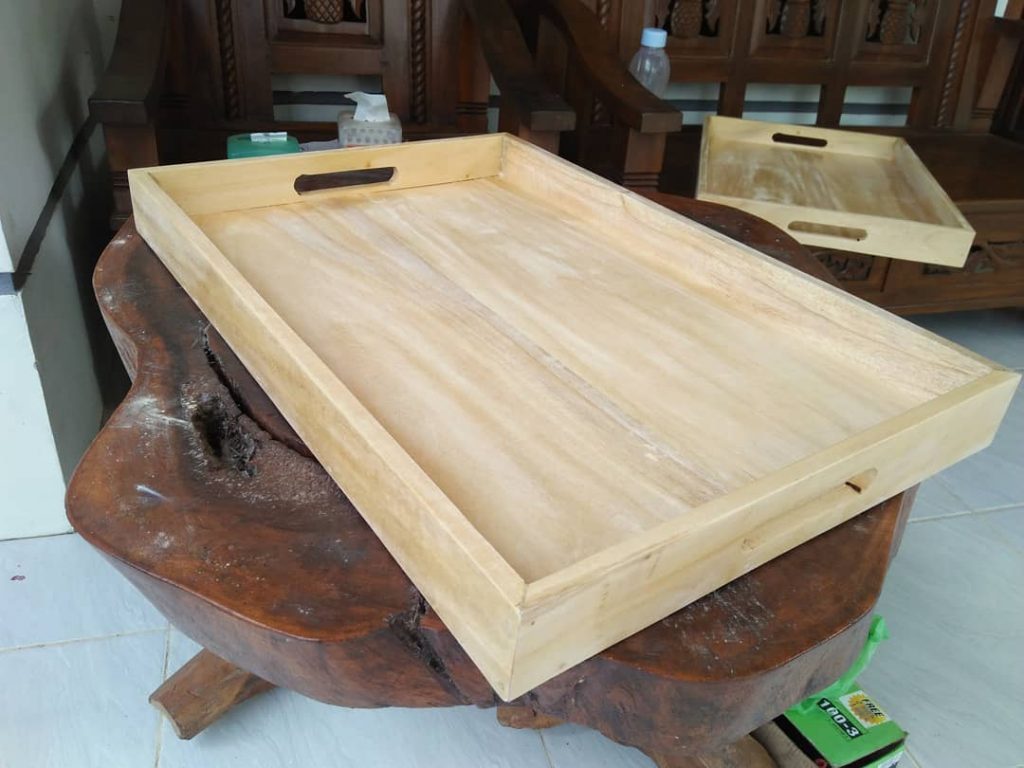To make the tray shown in Fig. 231, you will need a solid block of monostructured wood, preferably of dark color (beech, walnut). As an example, let us indicate the dimensions of this tray: 32x21x6 cm. The mahogany (Algerian eucalyptus) piece in the author’s possession had cracks, which were sealed with inlays of similar wood. The piece can be placed in the interior as decorative on a wall or on the horizontal plane.
Concave surface of the tray is formed by two large sheets of grapes, carved edges which are intertwined at the junction. The outline (for rigidity) is made in the form of curved branches, from which the stalks of the leaves and bunches, located under the leaves, depart. The berries, visible only from the side, create more stability, strength and massiveness of the piece. Three of them are placed so as to serve as supports for the tray when it is placed horizontally.
An advantage in the technique of making this piece is that its unstructured shape allows you to redo the failed spots. The increased size of the leaves against nature makes it easier to carve the veins, behind the whorls of the grapes and other elements.
On each of the leaves, the five main veins are made convex, while the others are grooved. Selection of the background after giving the leaves the necessary relief is carried out with half-circular chisels with the direction of cutting along those veins that branch off the central, convex ones. The technique of decorating the background of the leaves is similar to that used in the decoration of the grape bas-relief. However, the position, direction and size of the cuts in this case should create the shape of the leaf surface with its characteristic curves.
The background between the berries and twigs on the back of the tray has been processed with the same cuts with a semicircular chisel, mostly along the wood.
The sequence of the craft is as follows.
First, the workpiece is processed in the outline of the rounded perimeter. Semicircular chisels are selected cavity tray with some margin for refinement. Two grape leaves are drawn and cut out on paper, and their shape is refined by placing them directly in place. The contours of the leaves are outlined on the workpiece, then drills the appropriate diameter are made two holes in the middle of the product, ie at the bottom. Controlling the thickness of the bottom through these holes or with a wall thickness gauge, the bottom side of the tray is machined to remove the excess wood between the bunches. But this should be done with a parallel refinement of the shape and relief on the front side of the piece. For comparison, note that the greatest depth of a similar notch in the product, shown in Fig. 231, is 45 mm, if measured from the plane of the most convex points (the ends of the leaf petals).
After bringing the leaves to a rational thickness in the tray according to the drawing are drilled and clarified with a knife, as well as cutters through the contours of the holes. This makes it possible to finally decorate the front and then the bottom surface of the piece, controlling the thickness of the leaves through the slots.
Horelief carving of large berries is performed with half round chisels, each berry separately, with constant removal of the background wood between them. Although the clusters are on the back side of the piece, their composition, just like the composition of the grapes in each cluster, should be thought over, looking at the piece from all sides.
When cutting branches of grapes which wrap around the tray from the ends, you should not forget that their strength is weakened because of the cross direction of wood fibres, therefore several points of contact (anchor points) with branches or grapes should be provided in their design. For the same purpose, it is advisable to keep the thickness of branches about 15 mm.
A delicate but decorating operation is the carving of whorls of grapes at the bottom of the tray. It is necessary to do them specially, after careful drawing.
The background around them is chosen so that the scrolls were relief convex, and the wood is removed first from the inside of the scroll with semicircular chisels or chisels, and then – with the outside (preferably a knife) with a constant thinning.
Convex veins of leaves are made in the same way, but given the nature of the fine work and the risk of chipping in the directions perpendicular to the fibers of the wood, it is better to carve with one knife with a sharp tip. First, the knife is drawn with the blade in the direction of the pencil line, but close to it, with a strong forward slant. Then the background is trimmed on the outer side until a small groove is formed. The operation is repeated, but with the knife deepening the notch and widening the area of the selected background.
After that the wood on the other side of the pencil line is removed, but with some allowance for the thickness of the leaf vein. The carving is done in the same way as described above. The background is selected completely on both sides of the vein, and the vein itself is gradually thinned. The intersection of the veins is the last node to be carved. It is leveled slightly above the beginning of the leaf stalk.
Similarly (using a knife, with an incision on both sides) deep grooves of veins are made. In this operation, the knife can be replaced by a cutter, if the craftsman is skilled in working with it, as well as an angle in those places where concave veins go along the wood fibers.
FRUIT TRAY
